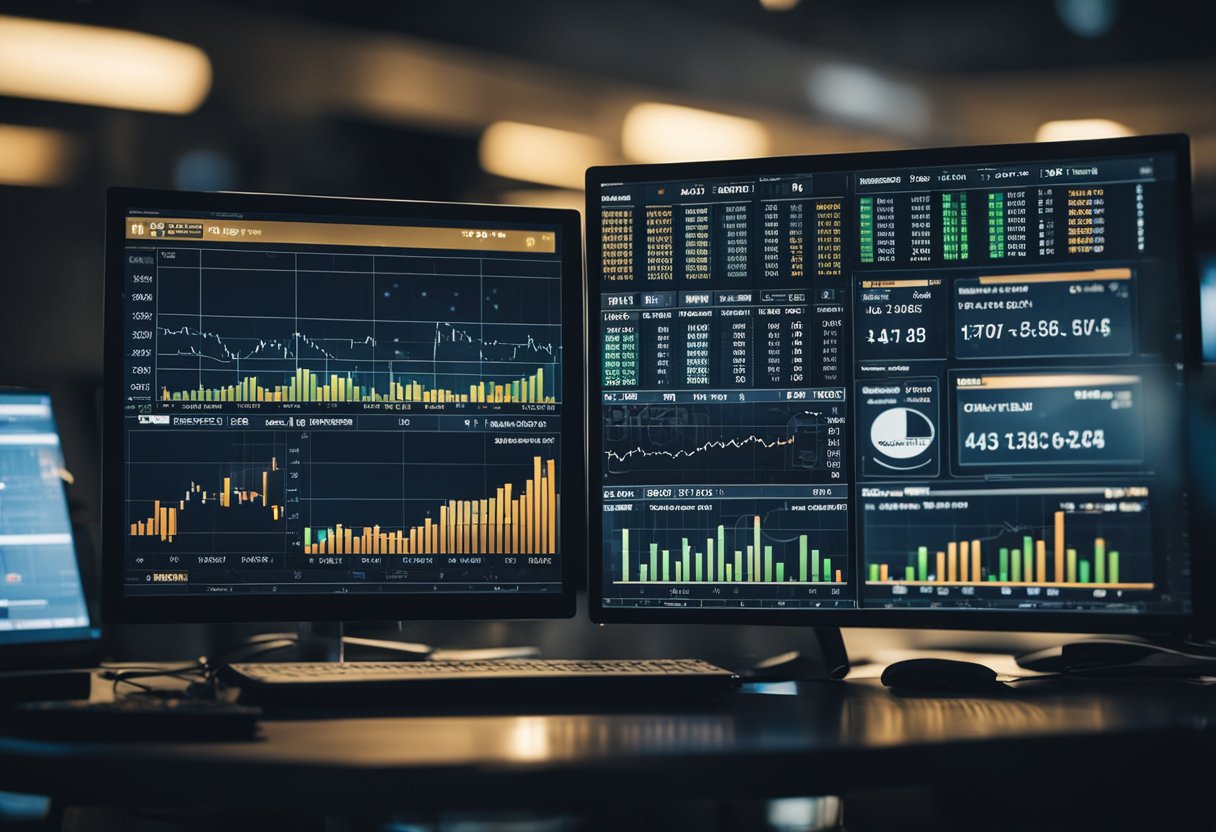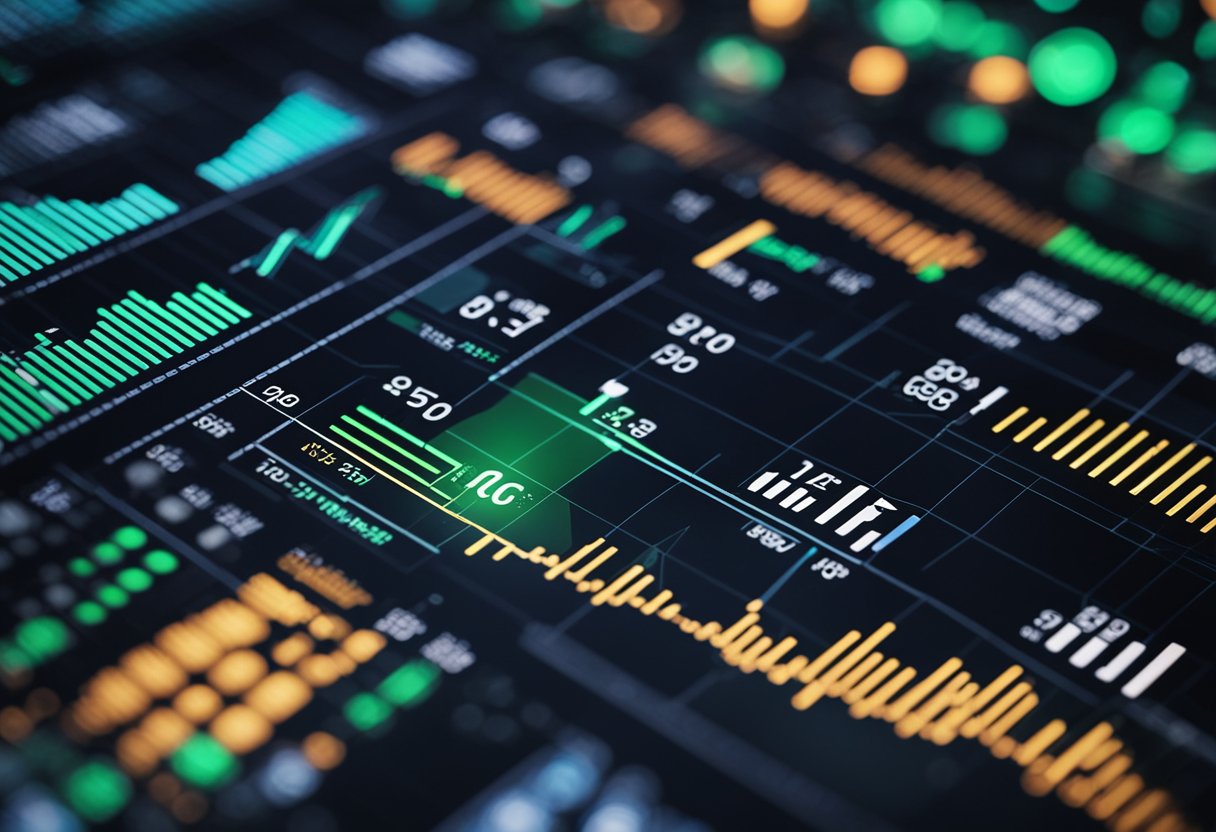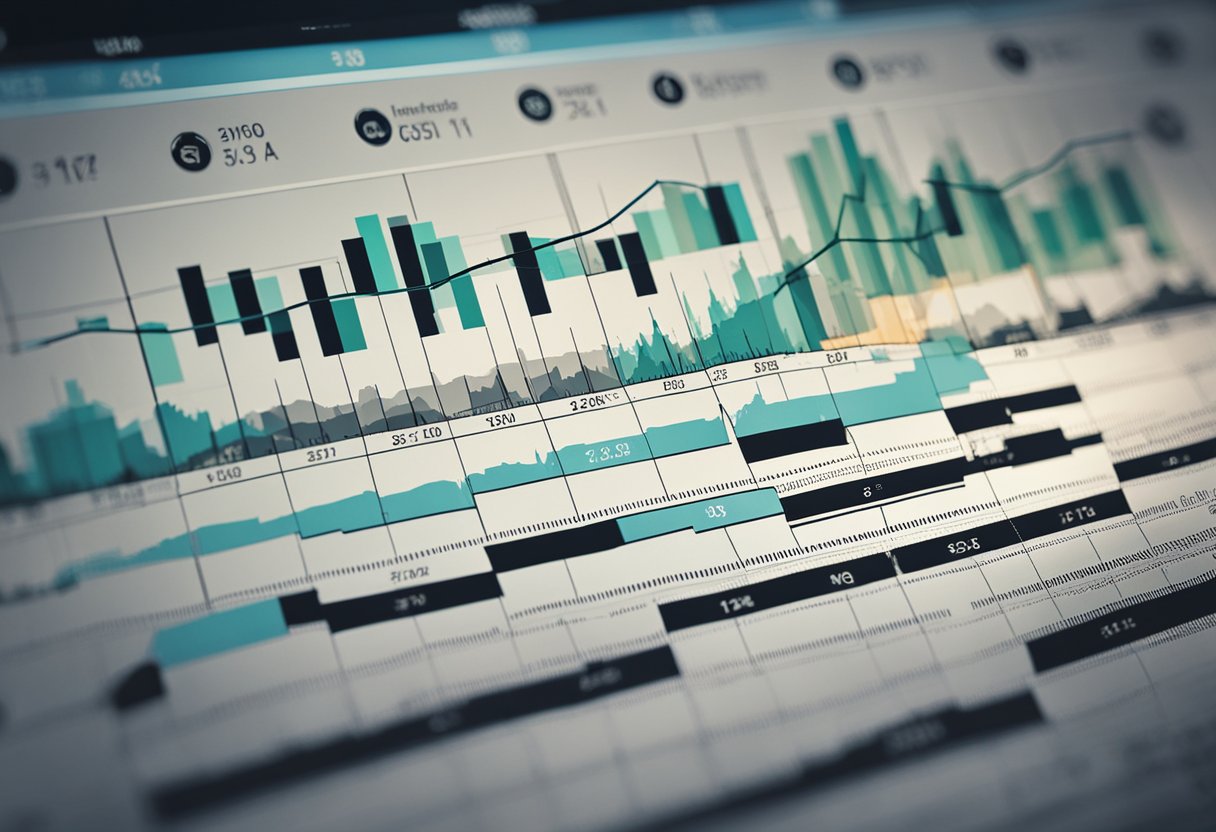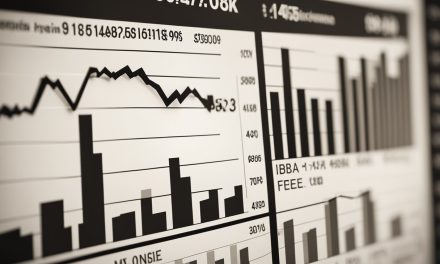The world of cryptocurrency trading has seen tremendous growth in recent years, as digital assets like Bitcoin and Ethereum have drawn in a diverse range of participants. Technical analysis, a crucial aspect of trading, assists traders in making informed decisions by examining historical price movements, chart patterns, and indicators to predict future market trends. This approach can prove to be extremely valuable for both new and experienced investors in the volatile cryptocurrency space.
Understanding how to conduct technical analysis for cryptocurrency trading requires a deep dive into various concepts, such as reading and interpreting charts, using key technical indicators, and recognizing critical market trends. Moreover, familiarizing oneself with support and resistance levels, as well as honing different trading strategies, can provide a solid foundation for achieving success as a crypto trader.
Key Takeaways
- Technical analysis involves examining historical price movements and indicators to predict future market trends for cryptocurrencies.
- Acquiring skills in reading charts, understanding key indicators, and recognizing market trends is vital for successful crypto trading.
- Developing effective trading strategies and familiarity with support and resistance levels can enhance decision-making for cryptocurrency traders.
Understanding Cryptocurrency Trading
Fundamentals of Trading
Cryptocurrency trading involves buying and selling digital assets like Bitcoin, Ethereum, and other cryptocurrencies to generate profits. Just like traditional stock trading, the primary goal is to buy low and sell high, thus capitalizing on market fluctuations. There are two main approaches to trading: Technical Analysis (TA) and Fundamental Analysis. TA uses historical price data and trading volumes to predict future market trends, while Fundamental Analysis considers factors such as project development, team expertise, and market sentiment.
To get started in cryptocurrency trading, you will need:
- A cryptocurrency exchange account, like Binance or Coinbase.
- A basic understanding of trading concepts such as candlestick charts, order books, and trading pairs.
- Familiarity with market indicators and technical analysis tools.
Cryptocurrency Market
The cryptocurrency market is a rapidly growing, decentralized, and global marketplace for digital assets. It operates 24/7, allowing traders to buy and sell cryptocurrencies anytime, anywhere. Cryptocurrency exchanges like Swyftx Learn facilitate crypto trading by enabling the exchange of one cryptocurrency for another or for fiat currencies like USD, EUR, and JPY.
Here are some key characteristics of the cryptocurrency market:
- High volatility: Crypto markets are known for their sharp price fluctuations, presenting opportunities for both profits and losses.
- Decentralization: Unlike traditional stock markets, the crypto market is not regulated or controlled by a central authority.
- Liquidity: Some cryptocurrencies, particularly Bitcoin and Ethereum, have high liquidity, meaning they can be easily bought and sold without significantly impacting their price.
Crypto Market Indicators
Crypto market indicators are important tools used by traders to analyze and predict price trends in the market. These indicators can be classified into three main categories: Trend indicators, Momentum indicators, and Volatility indicators. Examples of popular technical indicators include:
- Moving Averages: These measure average prices over a specified number of periods, smoothing out price fluctuations and identifying trends.
- Relative Strength Index (RSI): The RSI is a momentum indicator that measures the speed and change of price movements, helping traders to identify overbought and oversold conditions.
- Bollinger Bands: These are volatility indicators that display upper and lower price boundaries around a moving average, showing when the market is experiencing high or low volatility.
By understanding various market indicators, traders can create informed strategies for buying and selling cryptocurrencies, ultimately increasing their chances of success in this dynamic and exciting market.
Technical Analysis Overview
The Art of ‘TA’
Technical analysis (TA) is a widely used method for studying and predicting the future price direction of cryptocurrencies. By analyzing historical price data, traders and investors can identify patterns and trends that may indicate the trajectory of a given asset in the market1. TA focuses on price action, volume, and other market indicators, allowing for a comprehensive understanding of market behavior.
An essential aspect of TA is the use of charts and visual representations to help analyze data2. This can include bar charts, candlestick charts, and line charts that depict price movements over time. Additionally, a range of technical indicators can be employed, such as moving averages, Relative Strength Index (RSI), and MACD, to assist in decision-making.
Value in Trends
In TA, identifying and understanding trends is vital to making informed trading decisions. Trends can indicate the general direction of prices and signal the most opportune moments for buying or selling a particular cryptocurrency. There are three primary types of trends: uptrends, downtrends, and sideways trends3.
- Uptrends: Characterized by higher highs and higher lows in price action. This signifies that the demand for the asset is increasing, and the price is continually rising.
- Downtrends: Characterized by lower highs and lower lows, revealing that the supply exceeds the demand, causing the price to fall.
- Sideways trends: Also known as a consolidation phase, this occurs when the asset’s price moves within a reasonably stable range due to balanced supply and demand.
To accurately identify trends, traders often use trendlines that connect a series of highs or lows on a price chart. These lines indicate the prevailing direction of the market and can serve as a reference point for potential support and resistance4.
In conclusion, TA plays a crucial role in cryptocurrency trading by providing insights into market behavior and trends. By mastering the art of TA and understanding the value in trends, traders can make more informed decisions and potentially increase their chances of success in the volatile world of cryptocurrencies.
Footnotes
Reading and Interpreting Charts
Basics of Chart Reading
In cryptocurrency trading, understanding the basics of reading charts is crucial. One common type of chart used in trading is the candlestick chart. A candlestick chart presents price data in a visually appealing manner, with each candlestick representing a specific time period. A candlestick consists of a body and wicks, which display the opening, closing, highest, and lowest prices during that time period. If the closing price is higher than the opening price, the body is typically colored green or white. Conversely, if the opening price is higher than the closing price, the body is usually red or black.
Apart from candlesticks, traders often use other types of price charts, such as line charts and bar charts. Each type of chart has its advantages and limitations, but all of them aim to provide a clear representation of price movements over time.
In addition to understanding the different types of charts, it is important to familiarize oneself with various chart patterns. Some basic chart patterns include:
- Trendlines: Straight lines drawn through price points to indicate general directions of price movements.
- Support and resistance levels: Horizontal lines drawn at price levels where buying or selling pressure creates a pause or reversal in the price trend.
- Moving averages: Calculated by averaging the closing prices over a certain number of periods and then plotting the result on the chart, creating a smooth line that filters out short-term fluctuations and helps to identify the overall trend.
Advanced Chart Patterns
As traders become more experienced, they can start to recognize and use more advanced chart patterns in their technical analysis. These patterns, which often have distinct shapes and names, can be powerful indications of price movement directions and potential trade setups. Some examples of advanced chart patterns are:
- Head and Shoulders: A reversal pattern characterized by a peak (head), flanked by two lower peaks (shoulders), suggesting that an upward trend is coming to an end and a downward trend is about to begin.
- Double Tops and Bottoms: Resembling the letter “M” or “W,” these patterns indicate that the price is having difficulty breaking through a particular resistance or support level, signaling a potential trend reversal.
- Triangles and Rectangles: These patterns show price movements within narrowing or parallel boundaries, indicating a period of consolidation before a potential breakout.
Importance of Wicks and Body
In a candlestick chart, the wicks and body of each candlestick provide valuable information about the price behavior during a specific time period. Wicks indicate the intra-period extremes while the body reveals the difference between the opening and closing prices.
Long wicks, especially those extending above or below the body, can represent heightened trading activity or volatility during the period. A long upper wick, for example, can signal that buyers pushed the price up before it met resistance and fell back down, while a long lower wick could indicate that sellers pushed the price down before it found support and rose again. This can help traders to identify potential levels of support and resistance, as well as to gauge market sentiment. On the other hand, short or absent wicks generally imply a more stable or one-sided market.
In conclusion, understanding how to read and interpret various types of charts, especially candlestick charts, is a crucial skill for cryptocurrency traders. Recognizing basic and advanced chart patterns, and paying attention to the wicks and body of candlesticks, can help traders make informed decisions and potentially increase their chances of success in the market.
Key Technical Indicators
Types of Indicators
When it comes to technical analysis in cryptocurrency trading, there are numerous technical indicators that traders can employ to study market trends and predict future price movements. Some popular types of indicators include moving averages (simple, exponential, and weighted), oscillators like the Relative Strength Index (RSI), and trend-following tools like the Moving Average Convergence Divergence (MACD).
- Moving Averages (MA): MAs are utilized to identify trend direction by smoothing out price data from specified periods.
- Relative Strength Index (RSI): This oscillator measures the strength of recent price changes to determine overbought or oversold conditions.
- Moving Average Convergence Divergence (MACD): This momentum indicator helps to identify bullish and bearish trends by analyzing the relationship between two moving averages of a cryptocurrency’s price.
Understanding Volume and Momentum
Volume and momentum are two vital aspects of technical analysis, as they offer insights into the market’s strength and direction. Volume refers to the number of shares or contracts traded, while momentum measures the rate of change in an asset’s price.
Volume: High trading volume can indicate a strong market interest in a particular cryptocurrency or stock. Analyzing volume can help traders gauge the strength of a trend or identify potential reversals.
Momentum: Momentum indicators, such as the MACD, provide vital information about the velocity of price changes. Combining volume analysis with momentum indicators allows traders to develop more refined and informed trading strategies.
Utilizing TradingView
TradingView is a popular online platform that offers advanced charting and analysis tools to aid traders in understanding the market trends and conducting technical analysis. The platform provides various technical indicators, including the ones mentioned above, which traders can apply to a range of assets, including cryptocurrencies.
Users can customize their charts by adding or modifying indicators, adjusting timeframes, and changing chart types (e.g., candlestick, line, or bar charts). The wealth of information and tools available on TradingView makes it an invaluable resource for both novice and experienced traders looking to enhance their understanding of technical analysis in the growing world of cryptocurrency trading.
Understanding Market Trends
Bullish and Bearish Market
In cryptocurrency trading, it is essential to understand the two primary market trends: bullish and bearish. A bullish market is characterized by an overall upward trend in prices, indicating a positive market sentiment and increased buying pressure. On the other hand, a bearish market represents a downward trend in prices, reflecting negative sentiment and increased selling pressure. Identifying whether the market is currently bullish or bearish can assist traders in making informed decisions.
Trend Lines and Channels
A critical part of understanding market trends is analyzing trend lines and channels. Trend lines are straight lines drawn on a price chart to visualize the market’s general direction. They can be drawn by connecting the lows in an uptrend or the highs in a downtrend. These lines act as support or resistance levels, helping traders to identify entry and exit points for their trades.
Channels are formed by drawing parallel lines to the trend lines, creating a range within which the price moves. They represent the upper and lower boundaries of the trend and can reveal potential areas of support and resistance within the trend. Recognizing trend lines and channels is crucial for traders to gain insights into market trends and estimate the direction and magnitude of future price movements.
Market Sentiment Analysis
A thorough understanding of market sentiment is vital in technical analysis for cryptocurrency trading. Market sentiment refers to the collective attitude of market participants towards the market and specific cryptocurrencies. Analyzing market sentiment involves evaluating the emotions, opinions, and beliefs driving the buying and selling decisions of traders.
There are various tools and methods to gauge market sentiment, such as:
- Social media analysis: Evaluating the volume and sentiment of social media posts related to a specific cryptocurrency can provide valuable insights into the market’s perception of that asset.
- News analysis: Tracking news related to the crypto market or a specific cryptocurrency can help assess the overall sentiment.
- Market positioning indicators: Indicators such as the long-to-short ratio can give insights into the market’s expectations for the future direction of a cryptocurrency’s price.
In conclusion, understanding market trends and their underlying concepts is crucial for successful cryptocurrency trading. By analyzing bullish and bearish markets, trend lines and channels, and market sentiment, traders can make well-informed decisions and develop effective strategies for navigating the volatile crypto market.
Recognizing Support and Resistance Levels
Defining Support and Resistance
Support and resistance levels are fundamental concepts in technical analysis for cryptocurrency trading. They help traders identify potential entry and exit points when determining trade opportunities. The support level is a price point at which an asset experiences buying pressure, preventing its price from falling below that point. Conversely, the resistance level is a price point at which selling pressure emerges, preventing the price from rising above it.
There are various indicators to identify support and resistance levels. Some of these indicators include round numbers, moving averages, trendlines, pivot levels, and historical data1. When analyzing a trading chart, support and resistance levels create a trading zone that marks where a crypto asset’s price tends to bottom out (buy signal) and when it tends to top out (sell signal)2.
Correlation with Price Fluctuations
Support and resistance levels play a critical role in understanding price fluctuations of cryptocurrencies. Fluctuations occur when a price breaks through either the support or resistance level, usually resulting in a new trend. Here are some scenarios to consider:
- When the price breaks above the resistance level, it may signal a bullish trend, and the previous resistance may become the new support level.
- When the price falls below the support level, it could indicate a bearish trend with the previous support likely to turn into the new resistance level.
Traders can utilize stops and limits, pending orders, and corrective structures as the main support and resistance strategies to execute trades at these key price points3. It’s important to monitor these levels closely, as they offer valuable insights into potential market turning points and trend reversals. In summary, a thorough understanding of support and resistance levels can significantly enhance a trader’s ability to predict price fluctuations and make well-informed decisions in the competitive world of crypto trading.
Footnotes
Trading Strategies
Effective Trading Strategies
When it comes to cryptocurrency trading, having a well-defined strategy increases the chances of success. Some effective trading strategies include:
- Trend following: This involves identifying and following the direction of a market trend. It is applicable to both short-term and long-term trading.
- Swing trading: Traders capitalize on price swings within a range-bound market or between support and resistance levels.
- Scalping: This short-term strategy aims for small, frequent gains throughout the trading day.
Incorporating various technical indicators, such as Moving Averages, Relative Strength Index (RSI), and Bollinger Bands, can help traders fine-tune their entry and exit points.
Fundamental and Technical Analysis Comparison
Cryptocurrency traders rely on two main approaches when building a trading strategy: fundamental analysis (FA) and technical analysis (TA).
Fundamental Analysis (FA) examines the underlying factors that influence a cryptocurrency’s value. It involves analyzing project teams, market competition, use cases, and economic events. FA helps traders determine the inherent value of a cryptocurrency and its long-term potential.
Technical Analysis (TA), on the other hand, focuses on studying price charts and patterns to forecast future price movements. TA uses past market data and various indicators to identify trends and make well-informed trading decisions. This approach is suitable for short-term and day traders who aim to profit from price fluctuations.
Both methods have their merits, and a combination of FA and TA can provide traders with a comprehensive understanding of the market.
Risk Management Strategies
Effective risk management strategies are crucial for successful cryptocurrency trading. Here are some essential methods to mitigate risks:
- Diversify your portfolio: Investing in multiple cryptocurrencies reduces the impact of a single coin’s poor performance. Diversification helps spread the risk.
- Set stop-loss orders: Stop-loss orders protect traders from significant losses by automatically selling a cryptocurrency when its price falls below a predetermined level.
- Maintain a healthy risk-to-reward ratio: This helps ensure that potential profits outweigh the possible losses. A ratio of 1:3 or higher is considered favorable.
- Avoid over-leveraging: Leveraging amplifies both gains and losses, increasing the risk. Use leverage cautiously and keep it to a manageable level.
By employing these strategies, cryptocurrency traders can better manage their risks and enhance their chances of success in the volatile crypto market.
Becoming a Confident Crypto Trader
Importance of Community
Becoming a confident crypto trader involves not only learning the technical skills but also understanding the importance of a supportive community. Joining groups and forums where traders discuss strategies, share experiences, and provide valuable insights can help beginners navigate the constantly evolving world of cryptocurrency trading. Engaging in conversations with fellow traders ultimately builds confidence and enhances decision-making abilities when it comes to investing and trading.
Understanding Technology and Reputation
A key aspect of successful crypto trading is having a thorough understanding of the underlying technology and the reputation of projects you’re considering investing in. Before investing in a cryptocurrency, be sure to research its technology, use cases, and the team behind it. Evaluate how stable and promising the technology is, as well as the project’s long-term potential. This will help you make informed decisions based on fundamental factors, reducing the risk of loss in the volatile crypto market.
Recommendations for Beginners
- Start with a solid foundation: Acquire a comprehensive understanding of the basics of cryptocurrency trading.
- Follow reputable sources: Stay updated on the latest news and trends by following reliable sources, such as Forbes and other well-known finance websites.
- Learn Technical Analysis: Enroll in courses such as “Cryptocurrency Trading: Technical Analysis Masterclass 2023” and “Bitcoin & Cryptocurrency Trading Course for Beginners 2023”, focusing on technical analysis to develop a strong skillset.
By building a solid understanding of the cryptocurrency market, surrounding oneself with a supportive community, and continually learning and improving one’s skills, a beginner can gradually transform into a confident and successful crypto trader.
Beyond Bitcoin: Other Cryptocurrencies
As the cryptocurrency market continues to evolve, many investors are looking beyond Bitcoin to explore other digital assets with promising potential. In this section, we will discuss the rise of Ethereum and delve into the importance of understanding tokenomics and the total supply of cryptocurrencies.
The Rise of Ethereum
Ethereum, the second-largest cryptocurrency by market cap, has seen significant growth since its introduction in 2015. Ethereum was designed to be much more than just a digital currency; it serves as a platform for decentralized applications (dApps) and smart contracts. This added functionality has attracted a plethora of developers and investors, fueling its rise in value and usage.
An important distinction between Bitcoin and Ethereum is their underlying technology. While they both utilize blockchain, Ethereum’s blockchain has a unique feature: the Ethereum Virtual Machine (EVM). This allows developers to create and execute smart contracts, which are self-executing agreements with the terms directly written into code. The EVM makes Ethereum more flexible and adaptable, leading to a myriad of real-world applications, including finance, supply-chain management, and even digital identity verification.
Understanding Tokenomics and Total Supply
When assessing a cryptocurrency’s potential, it is crucial to understand its tokenomics and total supply. Tokenomics refers to the economic framework and incentive structures embedded within a cryptocurrency, affecting its value and how it is distributed. Elements such as token distribution, allocation of transaction fees, and staking rewards all fall under tokenomics.
On the other hand, the total supply of a cryptocurrency refers to the maximum number of coins or tokens that will ever exist. Both Bitcoin and Ethereum have predetermined supply caps, with approximately 21 million Bitcoins and an eventual limit of around 120 million Ether respectively. A cryptocurrency’s total supply plays a significant role in determining its value by affecting its scarcity and potential for inflation.
Understanding tokenomics and total supply helps investors make more informed decisions when selecting cryptocurrencies for their portfolio. By evaluating the economic framework and supply constraints of a digital asset, they can better gauge its long-term growth potential and overall utility.
To summarize, it is important for investors to explore beyond Bitcoin and familiarize themselves with other cryptocurrencies like Ethereum. Additionally, understanding tokenomics and the total supply of digital assets is crucial in making informed investment decisions. Always remember to conduct thorough research and consult professional advice before venturing into any investment.
Frequently Asked Questions
What are the most effective tools for crypto technical analysis?
Several tools can help in crypto technical analysis, such as moving averages, Relative Strength Index (RSI), and the Bollinger Bands. Moving averages help in identifying trends, whereas RSI measures the market’s momentum and potential overbought or oversold conditions. The Bollinger Bands indicate price volatility and potential price targets. Each trader may have their preferred tools depending on their strategy and goals.
Which mobile apps provide comprehensive crypto technical analysis features?
Various mobile apps offer a range of technical analysis tools and features for crypto trading. Some popular ones include TradingView, Blockfolio, and Delta. TradingView is known for its extensive charting tools, rich indicators library, and social functions. Blockfolio and Delta focus on portfolio management and also provide market data and charts for analysis.
What are the best indicators to use in cryptocurrency trading?
There is no one-size-fits-all answer to this question, as different traders may have different preferences when it comes to indicators. Some of the popular crypto trading indicators are Moving Averages, RSI, Bollinger Bands, MACD, and Fibonacci Retracement levels. Traders often use a combination of these indicators to identify entry and exit points, confirm trends, and measure market strength.
Where can I find valuable resources to learn crypto technical analysis?
Several resources are available online to learn crypto technical analysis, including free articles, video tutorials, and more advanced paid courses. Websites like Swyftx Learn, OANDA, and Coin Bureau offer comprehensive guides and articles for beginners. Additionally, YouTube channels and discussion forums can be valuable sources of knowledge and feedback from fellow traders.
Which websites offer free and customizable crypto charts with indicators?
Several websites provide free and customizable crypto charts with a wide range of indicators. TradingView is a popular choice for its extensive charting tools, vast selection of indicators, and a strong community of traders that share ideas and strategies. Other options include Coinigy and CryptoWatch, which also offer charting tools and market insights.
How can I improve my skills in analyzing the crypto market?
Improving your skills in crypto market analysis requires a combination of education, practice, and experience. Dedicate time to learning technical analysis fundamentals, study chart patterns, and understand the various indicators. Engage with trading communities to share insights and learn from others’ experiences. Keep practicing on free demo accounts or use paper trading to test your strategies before applying them with real money. With time, your analysis skills will improve, and you can fine-tune your trading strategies to match your risk appetite and goals.
Conclusion
Technical analysis is a valuable and powerful tool for cryptocurrency traders aiming to make informed decisions based on historical price and volume data. This approach can help one recognize and understand market trends, support, and resistance levels while also utilizing various tools and indicators1.
An essential aspect of successful technical analysis lies in understanding crypto charts and the implications of different indicators. Some popular indicators include moving averages, Relative Strength Index (RSI), and Bollinger Bands2. These tools can help identify potential trade opportunities and market trends.
It’s crucial to remember that no single approach to technical analysis guarantees success. Crypto markets are notoriously volatile, and several factors may influence price movements. Hence, each trader must develop their unique blend of techniques, indicators, and risk management strategies to stay profitable3.
In summary, technical analysis for cryptocurrency trading is an indispensable skill for traders who wish to make well-informed decisions in this rapidly evolving market. By mastering the art of interpreting historical price data, market trends, and technical indicators, one can enhance their trading performance and potentially minimize their risks4.
Footnotes
-
https://www.coinbureau.com/education/crypto-technical-analysis/ ↩
-
https://www.bitforex.com/en/academy/crypto-basics/Introduction-to-Technical-Analysis-for-Cryptocurrency-Trading/ ↩
-
https://www.sofi.com/learn/content/crypto-technical-analysis/ ↩
-
https://www.oanda.com/us-en/trade-tap-blog/trading-tools-strategies/best-crypto-technical-analysis/ ↩








Recent Comments